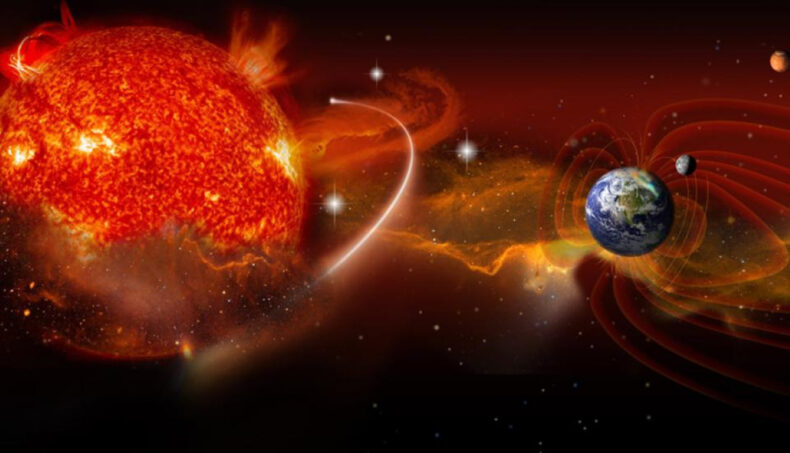A surge in solar activity has recently been noticed in the past few months. NASA (National Aeronautics and Space Administration) has attributed this phenomenon to the solar cycle, which entered its 25th cycle in 2019 and is expected to hit its peak in July 2025.
Solar storms, solar flares, geomagnetic storms, and other solar phenomena will continue to bombard Earth as a result of gradually increasing solar activity. Due to the sun’s distance from our planet, this solar activity may appear harmless, but it can seriously harm infrastructure. The blue planet will thus have to tough it out until the activity declines.
What is a geomagnetic storm?
Solar activity is the cause of geomagnetic storms. The sun is a bubbling hot cauldron of incessant activity that occasionally gives off solar flares, which in turn can trigger what’s known as a Coronal Mass Ejection (CME).
Along with the solar wind, CMEs will send a stream of solar particles into space. When charged particles from the stream strike the Earth, they will interact with our magnetic field and release energy into the upper atmosphere, changing the direction of our magnetic field.

The NASA Solar Dynamics Observatory (SDO) is one of many satellites and telescopes currently observing the Sun. Since 2010, the SDO has been observing the Sun with its full complement of instruments. To gather information about different solar activities, it makes use of three very important instruments.
These include the Atmospheric Imaging Assembly (AIA), which offers continuous full-disk observations of the solar chromosphere and corona in seven extreme ultraviolet (EUV) channels, the Extreme Ultraviolet Variability Experiment (EVE), which measures the Sun’s extreme ultraviolet irradiance, and the Helioseismic and Magnetic Imager (HMI), which takes high-resolution measurements of the longitudinal and vector magnetic field over the entire visible solar disk.

Why bother about geomagnetic storms?
Geomagnetic storms, although harmless to human health, compound their effects in conjunction with an agitated upper atmosphere, making long-range radio communications difficult and frequently leading to radio blackout conditions. GPS satellites may also encounter transmission issues during stronger solar storms.
The far reaches of Earth’s upper atmosphere can expand a little and touch some low-altitude satellites as it heats up from a storm’s effects. This could change the orbital plane of those satellites and increase their drag. Other satellites may accumulate static electricity charges as a result of the solar energy stream, which could cause harm if discharged.

Some of the strongest solar storms can even reach low enough altitudes here on Earth to disrupt power grids with voltage surges, as Montreal and Quebec experienced on March 13, 1989, during the great solar storm.
The Northern Lights, which can put on a vibrant, colorful display at night during geomagnetic storms, are the most well-known effects. The atmosphere’s nitrogen and oxygen interact with charged particles, briefly energizing the molecule before it de-energizes and emits light.

The new risk
The National Oceanic and Atmospheric Administration (NOAA) has recently warned the public about a potential CME impact that may occur soon.
According to a recent report, the Sun has released a CME that could hit Earth as early as May 16. This dim and sluggish CME was hurled into space by an NOAA forecaster on May 12, and it has been heading toward Earth ever since.

The report also stated that this CME impact could cause a G1-class geomagnetic storm. By greatly increasing the magnetic potential, they can seriously harm small satellites, have an adverse effect on mobile networks and GPS, and even pose a threat to ground-based electronics and power grids.













